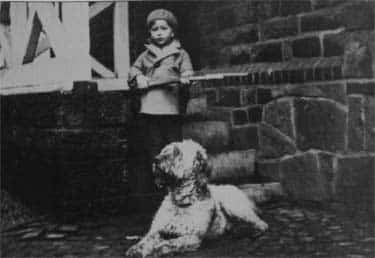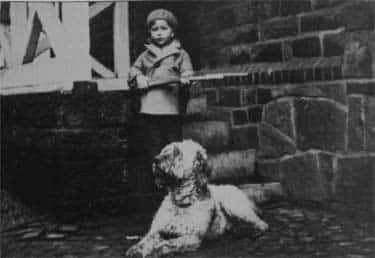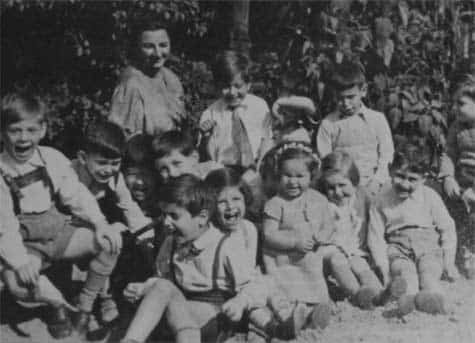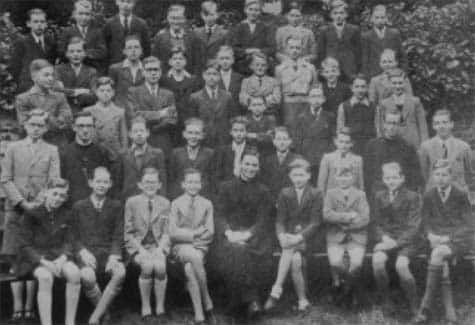by Beverly Lowy
“Childhood is a time when a
young person learns to love and trust. You were
taught a brutal lesson at an
early, early age, that the world of mankind was
not to be trusted. You began
a life without a childhood – call it ‘hidden
childhood’ – but you know you
were old before you were young. You lost so much
so early, even before you had a
chance to know what was lost.”
– BENJAMIN MEED, Founder/President American
Gathering/Federation of Jewish Holocaust Survivors,
addressing the First International Gathering of
Children Hidden During World War II.
“We have kept silence for 46 years in
the shadow of our parents and concentration camp
survivors. Now, at last, we are coming
out of hiding. We have been silent too long.”
– NICOLE DAVID, Hidden Child Committee.
They lived in convents, monasteries, seminaries; they lived with Christian families, sometimes with one or both parents; sometimes they survived on their own. They lived in sewers, woods, attics, crawl spaces. They lost their names, their identities, their religion. And when they emerged from hiding, no one wanted to hear their stories. After all, they were not camp survivors, their lives had been spared, they had not really suffered. And so these silent children have kept their silence into middle age. Many will keep it the rest of their lives.
Because the world trivialized their ordeals, the hidden children began to believe that their experiences couldn’t be terribly important. Daisy Miller, cofounder Child Survivors Group, Los Angeles, recounts that people who were in concentration camps often told her that she was “lucky.”
The damage has been done and it affects not only those who were hidden children but their mates
“Can you imagine ‘lucky?’ We were not lucky at all. It was horror all the way. When people asked me about myself, I found there was very little interest really. Sometimes I would be at a gathering or at a dinner party with some people and they would ask, as everyone does, ‘Where do you come from?’
“Tin from Europe. I was in Italy during the war – in hiding.’ And that person would very often say, ‘Oh really? Would you please pass the sugar to me?'”
The enormous outburst of laughter and applause that followed Miller’s statement showed that it was a very common experience for the people at this gathering.
Miller then expressed what many of the other speakers implied: “Somewhere, I suspect, we all have felt strangers in every land – strangers everywhere.”
Abraham Foxman, National Director Anti-Defamation League of B’nai B’rith and himself a hidden child, spoke of remembering the “monstrous past that robbed us of our childhoods and cast shadows on our lives ever since.” It is important for them to remember, to break the silence that has enshrouded them for so many years; but how can lessons so early taught, so frighteningly learned – to lie, to trust no one, to always think carefully before speaking, to reveal no personal weakness, to constantly expect disaster – be reversed by people whose ages today range from approximately 4762? The damage has been done and it affects not only those who were hidden children but their mates, children and even grandchildren. After nearly 50 years, the fallout from the Holocaust – referred to at the gathering as the Shoah – lives on.
I attended the conference not as a journalist but as the mate of a hidden child, seeking to understand the complex relationships that both my children and I have experienced with my husband – they for their entire lives, I for most of my adult years. Although I didn’t come away with any answers, I did gain a far deeper awareness of the factors that shaped his life and carried over into all of ours.
THE BARRIERS: STILL UNBROKEN
I collided with the barriers of mistrust and silence almost immediately. The first person I spoke with was a pleasant woman who asked where I was from. New York, I told her, and added that I was married to a hidden child but was not one myself. Then I asked where she was from. “North Carolina,” she replied, with a heavy European accent. “I meant, where in Europe are you from?” Silence. Thinking she might not have heard me, I repeated the question. More silence. I decided then not to ask anyone even the most innocuous questions.

So secretive are these survivors that I was surprised to see at the conference people I knew, some of them casually, others very well. One woman had been my closest friend in high school. Although I knew she came from Europe (this was in the late ’40s), I knew nothing of her experiences. She never spoke of them and I was hesitant to ask. Another attendee was the sister-in-law of a man I’d known for many years; my daughter had often played with his children. I had no idea that he and his brother were hidden children. He did not attend the conference, nor did my husband. In fact, I was to discover that many who did attend had come reluctantly at the urging of mates, relatives or friends. One woman said to me, “I only came because my friend insisted – and I don’t know why she wanted to come. She’s not even a hidden child.” This same woman told me she had been placed in a convent when she was too young to remember. Her father survived the war and when he came for her, she didn’t want to go with him. He was, by then, a strange man. Throughout her life she has had a conflict about religion (again, something that is quite common in this group), knowing that by heritage she is a Jew but has never felt Jewish. She also expressed what some others I spoke with voiced: “I’m an agnostic. If God could let so many children be killed, it’s not a god I believe in.”
CONFLICTS ABOUT RELIGION Children who began their lives as Jews were forced to conceal their Jewish identities to survive. Some have had a hard time regaining them; some never have. I found there was ambivalence among many about being Jewish, although it was not always apparent on the surface. One man said that his convent-reared wife became an Orthodox Jew after the war; she is very observant, keeps a strictly kosher house, does all the right things – but she, too, has never felt Jewish.
Many of the very young who were separated from their parents and brought up in Christian homes, convents or monasteries didn’t know they were Jewish until after the war. Those who were older during the Shoah began to see “Jewish” as something bad. After all, if it wasn’t a shameful thing, why was everyone their enemy? Why did those in power want to kill them? Added to that was knowing that their Jewish parents were unable to protect them, that they were dependent on Christians for their lives, and wondering why, if they were the Chosen People, God was allowing them to be slaughtered for nothing more than the “crime” of being Jewish. It’s small wonder that these children were confused and that so many later chose to repudiate or hide their Jewish identities.
Speaking with participants at the gathering, I sensed with a number of them an underlying fear: Even if they don’t really believe there will be another Holocaust, in some way being Jewish will always make them targets for hate or even death. Considering the increase in anti-Semitic incidents in this country and throughout the world, this fear is not unreasonable.
THE RIGHTEOUS AMONG THE NATIONS
An estimated 1.5 million children were slaughtered in the concentration camps. The estimates of hidden children are from 10,000 – 100,000. About 2500 were located by the Hidden Child Committee; approximately 1600 came to the conference.
There is no doubt that thousands upon thousands of Jewish children survived because so many Christians hid them. Sometimes whole families were hidden by people who risked their lives and the lives of their own children because they couldn’t just stand by. Abraham Foxman put it well: “Even in that hell called Holocaust there was goodness, there was love, there was compassion.” Yes, many of the Christian families received remuneration for hiding Jews, but no amount of money would have been sufficient had there not been true humanity and righteousness in these people.
Much has been said about the silence of the Catholic church during the Holocaust, but the fact remains that thousands of Jewish girls and boys were hidden in convents, monasteries and seminaries as well as in the actual living places of nuns and priests. Rabbi Harold I. Saperstein was an army chaplain and with the first division to enter Belgium. He recalled Father Andre, a priest in a small Belgian town, who hid whole families of Jews in his lodgings. According to Rabbi Saperstein, throughout the entire German occupation, Fr. Andre never slept in his own bed. When he ran out of space, he placed families with trusted members of his congregation.
| WHY THERE WAS A NEED FOR THE GATHERING “The First International Gathering of Children Hidden During World War II” was held in New York on May 26-27, 1991. According to the organizers, the participants, who came from all over the world, were there to at last share the pain caused by separation from and, in many cases, the loss of their families, and the guilt of having survived. It was obvious that many were there in hopes of finding some link to the past and some understanding of what had happened to them. The titles of the workshops evidenced what these survivors had suffered through these many years: Fear of Abandonment; Who Am I, Christian or Jew; Guilt and Loneliness of Surviving; Lost Childhood; fear of Remembering; Holocaust Trauma and fear of Relationships – these were but a few. Among the others were For Spouses of Hidden Children and For Children of Hidden Children, proving that the problems didn’t limit themselves to the hidden children alone. |
My husband, who was hidden in a seminary, recalls that priests were taken away to concentration camps as examples because the Germans knew they were hiding little Jewish boys. A woman I met at the conference spoke of finally getting her husband to return to Belgium in 1987 and to go to the monastery where he had been hidden. There they found a priest who remembered her husband. In the ensuing conversation her husband said, “You’ll never know how it felt to be here knowing that I was the only Jewish boy.” The priest replied, “When you were here, we were hiding 87 Jewish boys, just as we hid you.”
The clergy who hid these children certainly did not receive any financial benefit. My husband speaks warmly of the priests who risked, and sometimes lost, their lives to save them. “Perhaps they were out to save our souls for the Church,” he says, “but they certainly saved a hell of a lot of Jewish bodies.”
I spoke with Grace Caporino, an English teacher who teaches high school and college students about the Holocaust. Grace serves on the Teachers’ Task Force of the United States Holocaust Memorial Council and is a member of several Holocaust committees. A Catholic, Grace became involved in studying the Holocaust after reading Viktor Frankl’s book, Man’s Search for Meaning, shortly after she had brought two babies into the world. The book, she said, made her stop and think about just what kind of world she had brought children into.
At the conference, Grace was appalled when she heard over and over again how the Nazis used the catechism – something she could recite without thinking about it most of her life – as a way of determining whether a child was really Catholic. If the child could not recite the catechism unhesitantly in front of a selected priest, that child was shot. Grace said she felt “anguish that identification was made in that way; that another religion was used as a test whether you live or die.”
I mentioned to Grace that in reading over the Hiding Experience Directory, so many of the children appeared to have been saved by nuns and priests despite the non-intervention of the church. She replied that “institutions failed, not individuals.”
So these children were saved by those who cared enough to risk dying for what they thought was right. One of the most interesting entries in the Directory was by a woman who, as a child in Budapest, was saved by two German soldiers. And despite the anti-Semitism in Poland, both then and now, among the Righteous Among the Nations, one-third are Poles. In cataclysmic times, stereotypes fall.
SPOUSES OF HIDDEN CHILDREN
I entered the room with a mixture of trepidation and anticipation. This workshop was the main reason I had come to the conference. Although two oversized rooms were being used, both rapidly filled and people spilled out into the hall. Obviously there were many who felt as I did, who needed to exorcise the ghosts that haunted our lives. We wanted validation of our personal experiences and to speak with others who could relate to them. Here we could be candid, our honesty assisted by anonymity. I have always considered myself very bad at “trading war stories.” Now I was anxious to begin.

The section leader told us that we would go around the room and that those who chose to could pass. (Several people did.) Then she began by saying: “The hardest thing to deal with, at least for me, is the wall.”
Everyone understood exactly what she meant. No matter how much you care about your mate or want to share her/his life for better or worse, the wall is always there: Impenetrable, insurmountable, rejective of any real intimacy. No matter how long you live with this person, you will never really know her/him.
As we circled the room, each person who spoke spoke for all: Difficulties with trust; insecurity; excessive anger over trivia; inability to deal with rejection, real or imagined; refusal to speak of the hiding experience, except superficially; fear of abandonment; insensitivity to those who are closest to them. Also, many give the word “workaholic” new meaning while others find it difficult to stick to one career and either become proficient in many areas or drift. They make excessive demands on their mates and children without either being aware of it or meaning to. They are also, for the most part, charming, especially to the outside world, a trait they learned early would enhance their chance of survival. Because they so fear abandonment, they hate to have their children leave home or their mates to be away, even overnight. They view death as abandonment and often shock people for their seeming indifference to the death of a parent or other loved one. Their defense mechanisms are always in place. Dr. Haim Dasberg, a psychiatrist who is himself a survivor, described the adult hidden children as tenacious, resilient, altruistic and restless achievers who are “also sad because they constantly look at severed roots and uprooted identities.”
These are people who have suffered greatly, the more so for doing it in silence. In addition, they have more than their share of guilt for having survived when so many died.
One man spoke of his wife, who still has terrible nightmares and depressions even after years of therapy. She and her family were in hiding – eight of them in an attic. She was seven years old at the time. Then she contracted severe tonsillitis, was unable to swallow and had a high fever. A Jew couldn’t receive medical treatment so the woman who was bringing them food took her to the hospital, saying the child was a relative. After surgery and two weeks in the hospital, she returned to the attic, only to discover that her entire family had been found by the Nazis and killed. For the rest of her life she has wondered why she was spared. The attendant guilt has been unbearable.
As far as therapy is concerned, many spoke of having their mates involved in individual and/or family therapy, sometimes for many years, but it never touched the root of the problem.
One of the men, a survivor of the camps married to a hidden child, said that he was far better able to cope with his experience than she with hers. “I knew I suffered,” he said, “and the world knew I’d suffered. No one really believes she suffered. After all, she was safe in a convent.” Several other camp survivors agreed.
Another man spoke of his wife who, at three months of age, had been placed with a Christian family. After the war, when her parents came to retrieve her, she began to scream and fight, not wanting to go with these strangers. To this day, although they are now very old, she has never called them mother or father and when she speaks of them to others, she calls them “the kidnappers.”
In that room we heard many stories: Children hiding in the woods alone; hiding in sewers where they nearly drowned; children who sneaked out of their hiding places at night to glean whatever scraps they could from garbage pails. And there were some stories too terrible to write. But even the “good” stories were terrible if you see them through the eyes of a child.
As an example, I was going to relate my husband’s story, which, on the surface, was one of the “good” ones, but he is still not ready to have it told. However, I do have permission to tell the story of a longtime friend, whose experience closely parallels my husband’s. Nevertheless, the agreement is that I won’t use his real name. He, too, is unready to come out of “hiding.”

I must say here that both men were extra lucky because far fewer males than females are believed to have survived. Circumcision made Jewish males easy to identify.
On the face of it, “Manfred Blum’s” account does not sound very traumatic. He was with his parents, they lived with a family, they had adequate food and he was able to attend school. But this is what lies beneath the surface:
He was nine years old, living in Germany. His mother paid dearly for them to be secreted in a truck that was headed for France. There they were to be joined later by his father.
As they rode along, they could see bodies lying in the road and hear and see people being shot. When they reached the French border, his mother was pulled from the truck and was about to be shot as a German spy. He doesn’t remember what saved her. Meanwhile, his father had been imprisoned in a French prison camp as a German alien.
Somehow, Manfred and his mother were able to reach Belgium. They were eventually reunited with his father, who had escaped from the camp. Then began the fleeing from place to place until they were finally given sanctuary by a family in Bruges. There his parents were hidden in a small basement room while he lived upstairs, was given a different name, attended school, was baptized a Catholic and even became an altar boy.
Although he speaks very little about his experiences, claiming he really can’t remember, he does relate one: The day he was in his room when he heard the tread of German boots tramping up the stairs. Then there was a heavy pounding at his door. He opened it, expecting to be shot. The Germans were looking for a black marketeer who used to live there. Although he was a child, Manfred had the presence of mind to speak to the soldiers in bad German, with a heavy French accent. He got away with it.
After the war, for Manfred, his mother and father, as for all refugees, including my husband and his parents, the struggle began to find a place to accept them. After two years they succeeded in finding a sponsor and came to the U.S. As with my husband, out of two large families, these three were the only survivors.
AN EFFORT TO RECAPTURE THE PAST
As I left the workshop, I saw five large bulletin boards. They were covered with yellowing photos, with notes, with pleas and messages: “Have you seen my sister…” “I’m searching for my child. Hans would now be 50…” “Does anyone recognize the second girl from the left…” Message after message, whole lives on small slips of paper. Still searching after nearly 50 years. Much of the searching seemed to be for an identity – a link to the past – someone who could validate that once they had belonged.

As I stood there, the realization came that mine would be the last generation to really remember World War II and the Holocaust. That even those just a few years younger knew it only from documentaries, from photos of bodies piled up like cardboard, from pictures of mass graves. And I recognized just how important it is for these hidden children to break their silence. The time has more than come for them to speak out and for the world to listen to what happened to them.
On an impulse I tore a piece of paper from my notebook and wrote my husband’s name, his hidden name and the place and dates of his hiding experience. I added our phone number and looked for a place to put it on those overflowing boards. I saw a spot, then realized there was no available tack. As I was about to turn away, I felt something fall on my shoe. It was a push pin that had dropped from nowhere. I tacked up the message and headed for the escalator.
As I took my last look around at all the people, at the messages, at the aging photos, I had the feeling that I had seen only the tip of the iceberg; that the disaster spread by the Shoah will continue in ever-widening circles; and that it may take until the grandchildren of the hidden children reach adulthood before we can assess the full extent of the damage. Perhaps not even then.
Elayne Clift is a journalist specializing in women, health, environment and international development issues.
